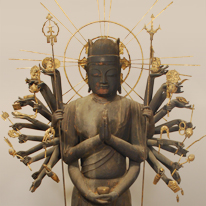Past Exhibitions
- Feature Exhibition: Buddhist Art from Tango
- July 26, 2016 - September 11, 2016
The Tango Peninsula, jutting into the Japan Sea, is part of northern Kyoto prefecture. With its maritime access to China and Korea and its close relationship to the longtime capital of Kyoto, the region has long served as an active crossroads for both people and objects. It also has a rich Buddhist heritage, with major temples housing sacred artworks dating from the Heian (794–1185) through Muromachi (1392–1573) periods. Recent research has revealed the special significance of its Heian and Kamakura (1185–1333) sculptures and its medieval Buddhist paintings and ritual objects.
Buddhist Art from Tango also features, for the first time ever, a tenth century “hidden” (hibutsu) Buddhist sculpture of the Thousand Armed Kannon (Avalokiteśvara) from the temple of Enjō-ji. This sculpture is normally kept enclosed and secreted from view, even at its temple. The Kyoto National Museum’s exhibition is an extraordinarily rare opportunity to view this revered icon in addition to a wealth of other masterworks bespeaking the ancient history and Buddhist culture of Kyoto’s seaside region.
- Japanese Sculpture
- July 26, 2016 - September 11, 2016
Before the Edo period, almost all Japanese sculpture was religious in nature. Buddhist sculptures were produced in Japan from the time Buddhism took hold in the seventh century, but the icons they represented came from India by way of China, bringing with them the influence of those countries.
One of the distinctive characteristics of Japanese sculpture is its use of wood as a primary material. Because sculptures were made of wood, various construction styles and techniques were developed, including joint-block construction (yosegi zukuri) and inlaid crystal eyes.
Japanese Buddhist sculptures from various historical periods exemplify the repeated waves of influence from the Asian mainland and subsequent Japanese innovations, leading to a rich variety of sculptural styles.












